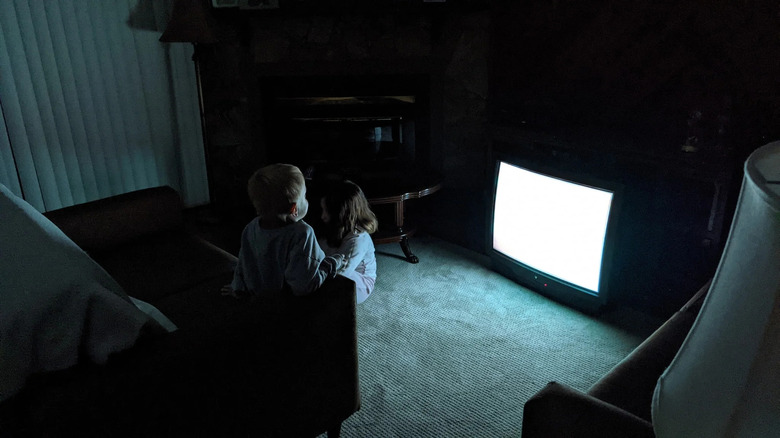
This post contains spoilers for "Skinamarink."
Writer/director Kyle Edward Ball's "Skinamarink" is a wholly thrilling experience, a horror film that teaches you how to watch it while you watch it, a brazen work of experimental art released into domestic multiplexes, and cleaning up in the process, it seems. One of its innovations lies in the way its cinematography and aesthetic are constructed out of liminal spaces. As /Film's Joe Roberts pointed out recently, Ball is an avowed fan of the meme, admitting that a subreddit devoted to liminal spaces influenced him when making the film. The subreddit defines the term using text from the Cambridge Art Association:
"A liminal space is the time between the 'what was' and the 'next.' It is a place of transition, a season of waiting, and not knowing. Liminal space is where all transformation takes place."
Gee, that sounds kinda similar to:
"You unlock this door with the key of imagination. Beyond it is another dimension — a dimension of sound, a dimension of sight, a dimension of mind. You're moving into a land of both shadow and substance, of things and ideas. You've just crossed over into the Twilight Zone."
The connection is no mere coincidence. Ball, that fan of the liminal, is also a fan of "The Twilight Zone," both the 1959-64 TV series (presumably) and (certainly) the 1983 film version. One segment of "Twilight Zone: The Movie," in fact, is directly referenced by "Skinamarink" in a variety of ways, and, at one point, nearly provided Ball with an alternate ending to his film.
Bimbo's Initiation
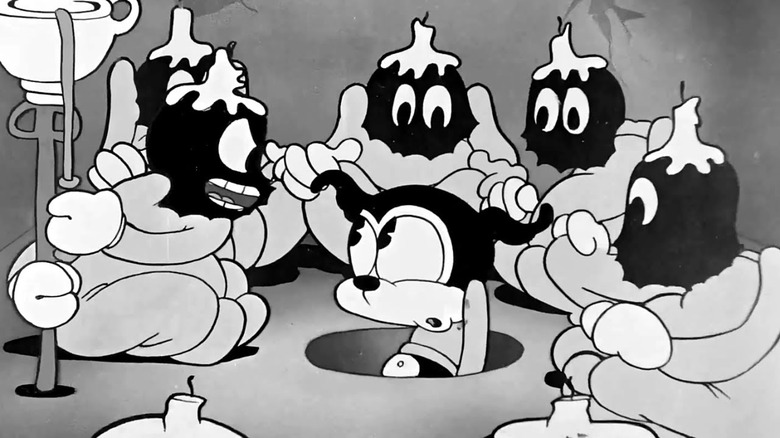
The main connective tissue between "Skinamarink" and "Twilight Zone: The Movie" is the 1931 cartoon "Bimbo's Initiation." Both films feature scenes with the cartoon playing on television, intermittently in "Skinamarink" and at a certain moment in Joe Dante's segment of "Twilight Zone," a remake of the episode entitled "It's a Good Life" from season 3 of the original series.
"Bimbo's Initiation" is a remarkable piece both in and of itself as well as within the realm of the uncanny. A "Talkartoon" made by Fleischer Studios, the short (directed by Dave Fleischer) involves the studio's "Bimbo" character, a mostly innocent, bumbling anthropomorphized dog who served as the main love interest to Betty Boop during her early years. Walking blissfully on the street, Bimbo accidentally falls into an open manhole (which is then locked shut by a character who looks suspiciously like Mickey Mouse) and finds himself in the lair of a secret society that continually asks if Bimbo would like to be a member. Each "no" from Bimbo sends him to a new room and a new death trap, which Bimbo narrowly avoids.
"Bimbo's Initiation" sends all laws of physics and any semblance of reality packing, with even the lair Bimbo finds himself trapped in changing shape at will, the space endless and claustrophobic all at once. Like many cartoons of the era, "Bimbo's Initiation" is chock full of sadism. The character is tortured by unknown forces for no good reason since he's not, for instance, an arrogant buffoon like Daffy Duck.
The secret society turns out to be hundreds of clones of Betty Boop, an early version of the character who sports dog-like features, which is a bizarre sight by itself for those who only know her more human look from later in her history.
I'm Wishing You In A Cartoon Land
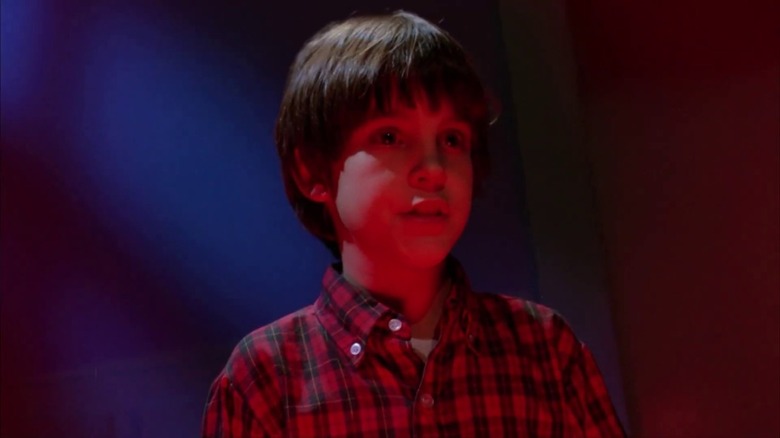
The "It's a Good Life" segment of "Twilight Zone: The Movie" follows a schoolteacher, Helen Foley (Kathleen Quinlan), who meets a young boy at a roadside bar, Anthony (Jeremy Licht). The boy convinces Helen to give him a ride home, only for her to find that Anthony has access to special supernatural powers that allow him to wish anything into (or out of) existence. Anthony's "family" are anything but — they're really strangers whom Anthony has lured to his home and held hostage with the threat of causing them harm or making them disappear if they don't participate in whatever he wants. What he wants is a daily birthday party, with cartoons playing on television around the clock.
One of those cartoons happens to be "Bimbo's Initiation," which is playing during a scene where Helen comes across Anthony's "sister," Sara (played by rock star Cherie Currie), whose fate for upsetting Anthony is to be forced to watch the toon on repeat. Anthony later sends another "sister," Ethel (played by the soon-to-be-Bart-Simpson, Nancy Cartwright) into a cartoon land. Joe Dante makes it clear that Anthony's entire world has become a demented cartoon, complete with an unsettling never-ending soundtrack and sound effects.
In "Skinamarink," siblings Kevin (Lucas Paul) and Kaylee (Dali Rose Tetreault) are trapped inside their house when a mysterious supernatural entity seizes power. Intending to stay together near the comforting safety of a television set in the living room, the siblings have old, public-domain cartoons playing constantly, one of which is "Bimbo's Initiation." The entity, ensuring any and all safe spaces are eradicated, begins to co-opt the cartoons, remixing and replaying them as it sees fit. In both films, "Bimbo's Initiation" acts as a perfect example of the "safe" world of cartoons becoming threatening, reflecting the characters and their entrapment.
Cursed Films
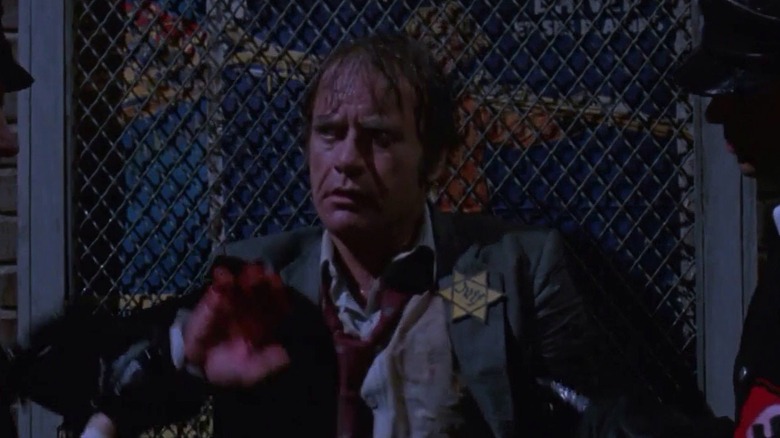
Of course, "Twilight Zone: The Movie" has another cultural connotation, one of the most notorious in Hollywood history. Infamously, while making John Landis' second segment of the film, actor Vic Morrow and two child actors (Myca Dinh Le and Renee Shin-Yi Chen) were killed in an accident involving a helicopter on set. The scene was aborted and never used in the movie, but the fallout still lingers to this day.
One of the aspects of horror that "Skinamarink" trades in is the internet-based Creepypasta genre, which, as defined by Darcie Nadel in 2021, are "scary stories or stories in the horror genre that are passed around forums or other sites across the Internet." The subgenre piggybacks on the unverified nature of posting, the "it-looks-true-so-maybe-it-is" aspect of blogs and social media. In that way, it's a 21st-century version of the urban legend, where reality itself has become a liminal space.
"Twilight Zone: The Movie," its "cursed" history, and its production during the last age of fully analog Hollywood fits neatly into the aesthetic of "Skinamarink," a movie from 2022 that is set in 1995 and looks like it was shot on film sometime during the late '70s or early '80s. For entirely separate reasons, both movies beg the question, "Should we be watching this?"
No Doors, No Windows — To The Soul Or Otherwise
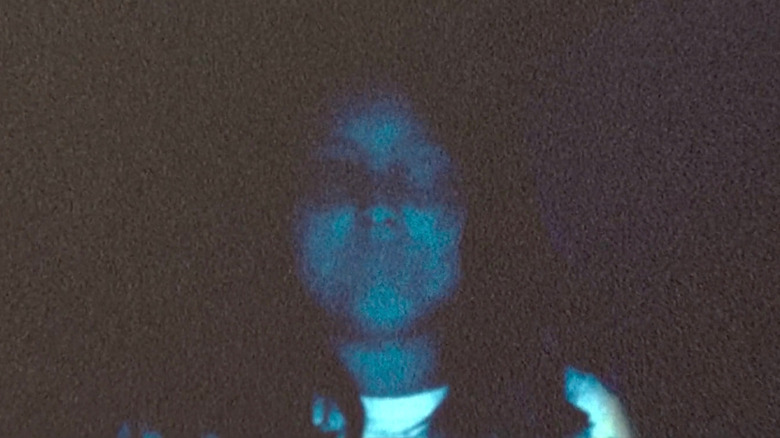
There are even more connections to be made between "Skinamarink" and "Twilight Zone: The Movie." The aforementioned scene of Helen discovering Sara watching "Bimbo's Initiation" includes the reveal that Anthony has wished Sara's mouth away, leaving her helpless and mute. One of the scariest scenes in "Skinamarink" features the entity calling Kevin down to the basement to see what's happened to Kaylee. After telling her brother that she feels scared and odd, Kevin sees her, and we get one of only two full-face close-ups of the entire film: Kaylee, horrifically and ironically missing her eyes and mouth.
The other full-face close-up of the film is the final shot of the movie, and it's yet another sadistic trick: a long, unbroken shot of what is presumably the entity's "face," which is no face at all. Ball invites us to stare through the film grain as Kevin repeatedly asks "What's your name?" to no avail.
No Safe Spaces
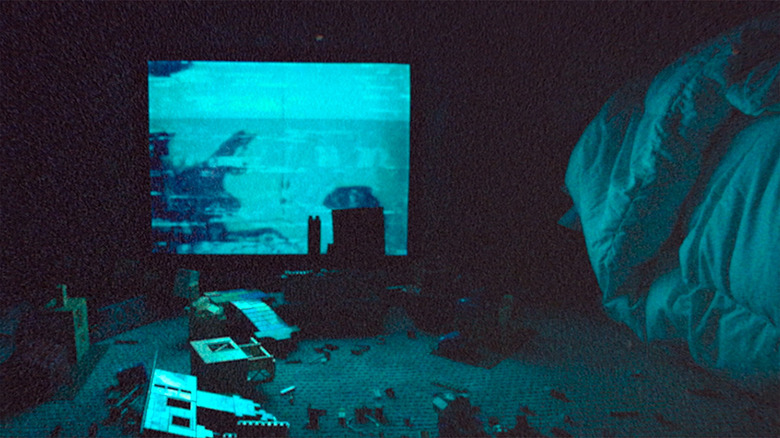
This was not Kyle Edward Ball's original concept for the movie's ending. As he revealed in an interview with Inverse, his ideas for the entity's representation changed a few times:
"[One] towards the end, that's the nineteenth iteration of it. Originally, it was something completely different. That was originally not in the script. At one point, there's a cartoon they're watching that has a spider monster. Then I did something where I stole something from 'The Twilight Zone' movie where it was going to be a giant eye. I went through a bunch of different iterations."
The moment Ball is referring to is likely this shot from, you guessed it, Joe Dante's segment, occurring when Helen is attempting to escape Anthony's house. In any case, both Dante's segment of "Twilight Zone: The Movie" and "Skinamarink" use similar images and the cartoon aesthetic to mock their fictional victims and disturb the audience. A pronounced lack of human features is the ultimate liminal space, an uncanny valley which also indicates that escape is truly impossible.
Just as "Twilight Zone: The Movie" begins with a segment featuring two lovable comedians (Dan Aykroyd and Albert Brooks) discussing the "Twilight Zone" TV show before things turn disturbing, just as "Skinamarink" lulls the viewer into calm, cartoon-soundtrack confusion before turning the experience into a waking nightmare, it becomes clear that there are no safe spaces: liminal, Zones, or otherwise.
Read this next: Horror Movies That Even Horror Fans Could Hardly Finish
The post The Eerie Connection Between Skinamarink and Twilight Zone: The Movie appeared first on /Film.
0 Commentaires